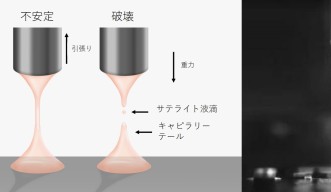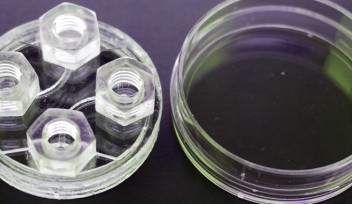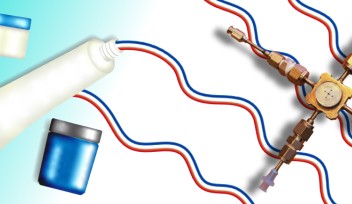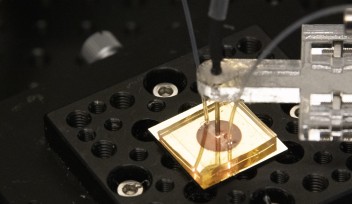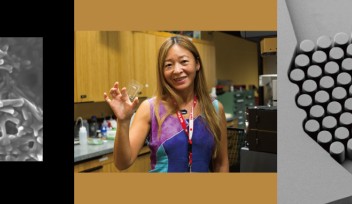A new “twist” to break viscoelastic liquid bridges

Highlights
- Scientists have developed a new method that improves dispensing of viscoelastic fluids – a vital process for circuit board production, 3D printing and other industrial applications
- Viscoelastic fluids are difficult to dispense as liquid bridges that form between the substrate and nozzle must be broken
- New research has found that twisting these liquid bridges breaks them in a quicker and cleaner way than the conventional method of stretching them
- Researchers used high speed imaging to observe that when twisted, a crack forms at the edge of the liquid bridge and propagates towards the center
- The underlying mechanism that breaks the liquid bridge was found to be “edge fracture” and is the first time that scientists have found a useful application for this phenomenon
Press release
If you’ve ever tried to lift a pizza slice covered in hot, melted cheese, you’ve no doubt encountered the long, cheesy strings that bridge one pizza slice from the next. Keep lifting the pizza slice and these cheese bridges eventually break, covering the plate, table (or even your lap) in long, thin strands of cheese. While this is just a minor inconvenience with pizza, it is a longstanding problem in industry, where liquids with similar properties to melted cheese – dubbed viscoelastic fluids – need to be cleanly and speedily dispensed.
Now, scientists have developed a new technique that uses rotation to break these liquid bridges. Their findings, published 11 June 2021 in PNAS, could improve the speed and precision of dispensing viscoelastic fluids, in applications ranging from circuit board production and food processing to live tissue engineering and 3D printing.
“Viscoelastic fluids, like ketchup, silly putty and toothpaste, have very strange properties – when squeezed slowly, they flow like a fluid, but at faster speeds, they act like an elastic solid,” said co-first author, San To Chan, who is a PhD student and JSPS DC2 Fellow in the Micro/Bio/Nanofluidics Unit at the Okinawa Institute of Science and Technology Graduate University (OIST). “These unique properties make dispensing these fluids quite difficult.”
Currently, the standard method in industry involves lifting the nozzle away from the surface on which the liquid has been deposited. Although this effectively breaks the bridge, it draws the deposited liquid up into a long, thin peak, known as a capillary tail. If the liquid bridge breaks in multiple places, small droplets of fluid, called satellite droplets, also form. Capillary tails and satellite droplets can contaminate products or short-circuit electronic chips.

“The higher the nozzle is retracted, the longer the capillary tail, so the greater the chance for contamination,” Chan explained. “Since the nozzle can’t be lifted too high, the liquid bridge is thicker and takes longer to break, which slows down the whole dispensing process.”
To overcome these challenges, Chan and his colleagues devised a simple solution: instead of stretching the liquid bridge, it could be destabilized through twisting.
In the study, the research team tested this idea on viscoelastic silicone oil, which is 60,000 times more viscous than water. The scientists placed a droplet of silicone oil between an upper and lower plate. Using high-speed imaging, they found that when the liquid bridge was twisted by rotating the upper plate, it caused a crack halfway between the ends of the liquid bridge. The crack then spread inwards from the edge towards the center, cutting the bridge cleanly in two without forming capillary tails or satellite droplets.
Importantly, this process took about a second, compared to the ten seconds typically needed to dispense the same fluid using the conventional retraction method.
For their next step, the scientists uncovered the underlying mechanism that causes the liquid bridge to break when placed under torsion. They teamed up with a research lab from Eindhoven University of Technology, who simulated what Chan and his colleagues had observed experimentally. The simulations provided concrete information about how the liquid bridge reacted, validating what the scientists had suspected: the crack was caused by “edge fracture”.
“This is particularly striking as edge fracture has been characterized as a really undesirable phenomenon that scientists try to stop from occurring,” said Dr. Simon Haward, who is the group leader for Micro/Bio/Nanofluidics Unit. “This is the first time that edge fracture has been found to have a beneficial application.”
In the next phase of their research, the team plans to experiment with different viscoelastic fluids to confirm that the same effect applies. They also plan to increase the speed of the dispensing process further, potentially by combining both rotating and retracting the upper plate.
“For many industries, swapping from a nozzle that retracts to one that spins is relatively easy, but it has far-reaching ramifications,” said senior author, Professor Amy Shen. “Faster and more precise liquid dispensing could lower energy consumption, and fewer contaminated products could mean that less raw material used.”
###
Header image by Sofiamcfly, CC BY-SA 3.0 , via Wikimedia Commons
Article Information
Title: Torsional fracture of viscoelastic liquid bridges
Journal: PNAS
Authors: San To Chan*, Frank P. A. van Berlo*, Hammad A. Faizi*, Atsushi Matsumoto, Simon J. Haward, Patrick D. Anderson, and Amy Q. Shen
Date: 11 June 2021
DOI: 10.1073/pnas.2104790118
*These authors contributed equally to the study.
Specialties
Research Unit
For press enquiries:
Press Inquiry Form










